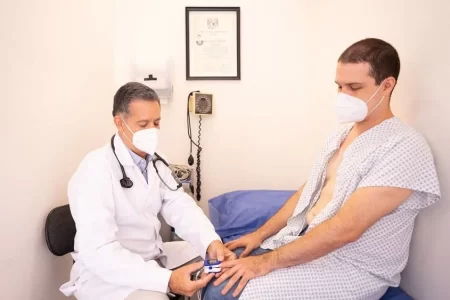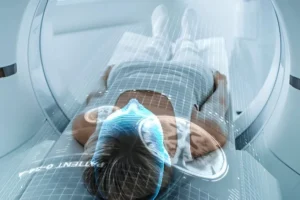Testing and Diagnosis of Prostate Cancer
- Updated on: Jul 6, 2024
- 4 min Read
- Published on Feb 21, 2021


Prostate Cancer Diagnosis
Regular testing increases the chances of cancer being detected at an early stage when the cure of the disease is possible. It is difficult to treat the prostate cancer if it has advanced to later stages and spread to other nearby areas such as bones.
Testing of a healthy man showing no symptoms for prostate cancer is controversial. Doctors do not agree about screening for prostate cancer in healthy individuals and also about whether it delivers any benefits. Some doctors recommend men to consider prostate cancer screening as they grow older, for men who are at high risk for prostate cancer.
You can explore various options to learn about testing and diagnosis for prostate cancer in this article.
There is no one definitive test for prostate cancer. Your doctor will discuss various tests with you to try to figure out which works best for your circumstances.
Your doctor may:
- ask you for a urine sample to test infection before prescribing any further test
- recommend a blood test to test level of prostate-specific antigen (PSA)
- perform a digital rectal examination
- examine your prostate gland
PSA Test
PSA is a protein that is produced by your prostate gland. All men have some amount of PSA in their blood. However, the amount increases with age.
Prostate cancer can increase the amount of PSA in your body, and therefore a PSA test can be used to detect the increased PSA levels in your blood which may be indicative of prostate cancer.
PSA testing though is not a specific test for prostate cancer. Most men who have prostate cancer will not have a raised PSA level. According to an estimate, about 70% of men with increased PSA levels will not have prostate cancer. PSA levels rise with age in all men.
To conduct the test, a pathologist will require your blood sample. The blood sample is drawn from a vein in your arm and is studied for the PSA. Detection of a small amount of PSA is absolutely normal. However, if a much higher than normal level is found, it may indicate either a prostate infection, or an inflammation, or an enlargement or a prostate cancer. Your doctor will then conduct other confirmatory tests if a prostate cancer or other disease is suspected.
Digital rectal examination (DRE)
After a PSA test is done, the next step is to perform a digital rectal examination.
Your doctor will insert a lubricated and gloved finger into your rectum to examine your prostate, which is close to the rectum. If your doctor finds any abnormalities in the form of a changed texture, changed shape or any change in size of the gland, he may recommend further tests. This will feel a bit uncomfortable, but would not be painful. Prostate cancer can make the gland hard.
In most cases, though, the cancer causes no changes to the prostate gland and this procedure may not be able to diagnose the cancer. DRE is helpful in ruling out other conditions such as prostate enlargement (benign prostatic hyperplasia).
Biopsy
A prostate biopsy, also known as a core needle biopsy or a transrectal ultrasound (TRUS), is used to determine if any suspected tissues are cancerous or not. It is usually conducted when your doctor finds abnormal lump during a digital rectal exam or if the PSA blood test confirms high levels of PSA in your bloodstream.
In this procedure, your doctor (or any other specialist of biopsy) will collect a sample of cells from your prostate (prostate biopsy). A thin needle is inserted into the prostate to collect the tissue. The tissue is analyzed in a lab to determine whether it is cancerous or not.
The procedure can be a little uncomfortable and sometimes painful too. You may be given a local anesthetic to minimize any discomfort. There may be certain complications such as bleeding and infection, as with many other procedures.
Biopsy is a reliable test compared to others such as the PSA test.
You may require another biopsy if your symptoms do not go, or your PSA level continues to rise or your other symptoms are persistent. There are chances that the sample taken for biopsy might not have the cancerous cells, and an appropriate tissue might have missed. Sometimes, your doctor may request an MRI scan of the prostate before performing another biopsy.
Biopsy is quite helpful. If cancerous cells are found, they can be investigated further to see how quickly the cancer will spread to other areas such as bones. This helps doctors to decide which treatment is the most suitable for you.
Magnetic Resonance Imaging (MRI)
MRI scans build a detailed picture of the inside of your body. Health professionals are increasingly using imaging technologies to diagnose and treat prostate cancer.
An MRI machine uses strong magnets and radio waves to create 3D images of organs, tissues, bones and blood vessels. Sometimes, MRIs are used to know if the prostate cancer has spread to surrounding tissues. This shows how invasive or aggressive the cancer is, and doctors can better determine the treatment options for you.
Ultrasound
Sometimes, your doctor may use transrectal ultrasound to further evaluate your prostate. A small probe is inserted into your rectum. The procedure uses sound waves to create a picture of your prostate gland.
Diagnosing if the Prostate Cancer is Aggressive
When a biopsy confirms the presence of prostate cancer, your doctor would like determine the level of aggressiveness (grade or stage) of the cancer cells. A pathologist will examines a sample of your cancerous cells to compare the cells with normal cells and determine how much the cancer cells differ from healthy prostate cells. This will tell him about how advanced the cancer is. A higher grade or stage indicates a more aggressive cancer which means it is more likely to spread quickly.
The most commonly used scale to evaluate the grade of prostate cancer cells is called ‘Gleason score’. The scoring system uses two numbers which can range from 2 to 10. A score of 2 indicates nonaggressive cancer and 10 indicates a highly aggressive cancer.
Genomic testing is also increasingly being used to more accurately evaluate the grade of prostate cancer.












